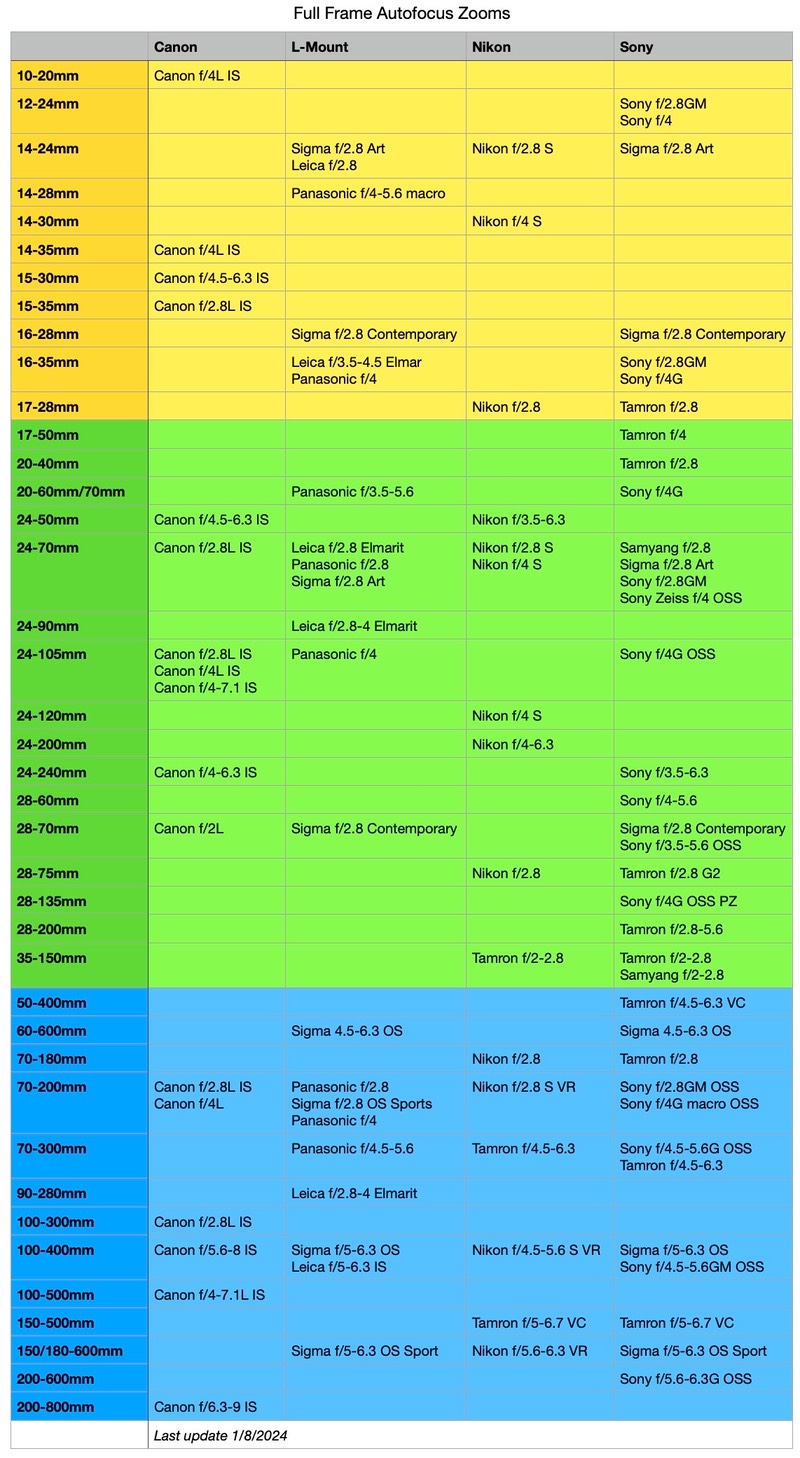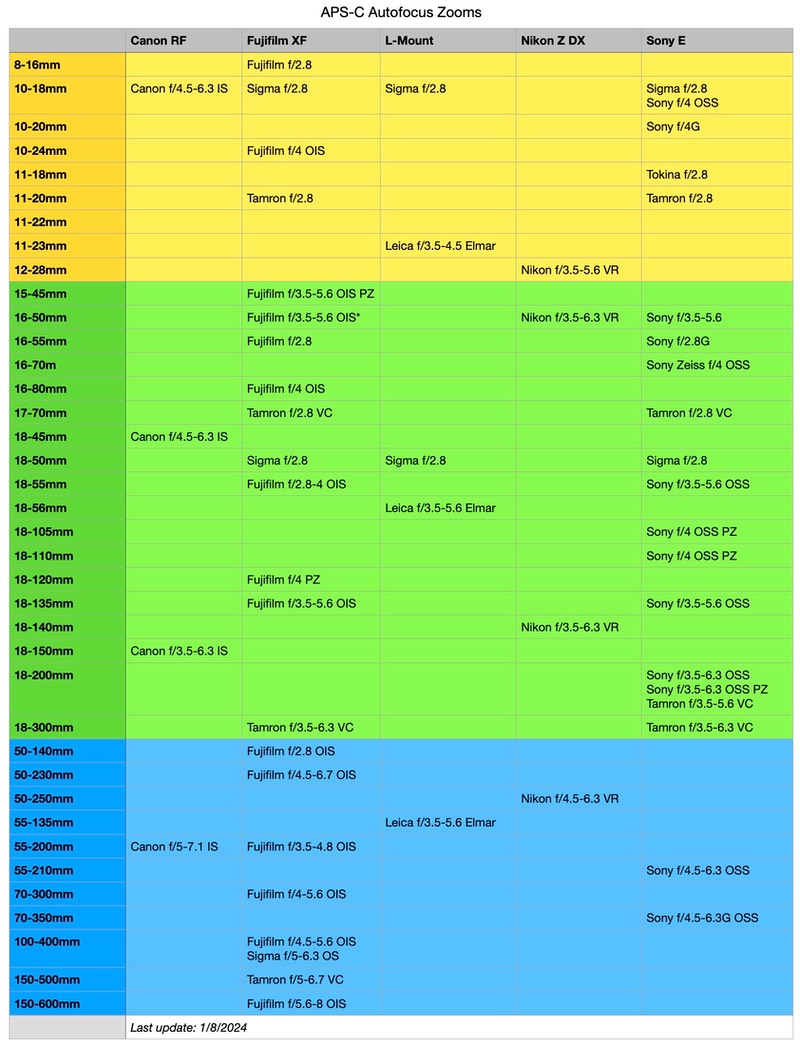Updated: 1/8/2024
Here's the full list of what I came up with for full frame, autofocus, zoom lenses that are currently available (organized by mount, in declining aperture order, alphabetically by brand):

You'll note I've used color in this table. The yellow section is wide-angle zooms, green is mid-range/superzooms, and the blue is telephoto zooms. Generally, zoom lens users tend to eventually end up with one of each type of zoom (or sometimes two lenses in two distinct zoom categories). That's because the notion of "zoom" is really "cover everything."
The photojournalism (PJ) needs eventually netted us a trio of zoom lenses, often called the Holy Trinity, which tended to be wide-angle, mid-range, and telephoto zoom lenses with an f/2.8 maximum aperture. You'll note in the full frame mounts, all three of the major mounts (RF, Z, and FE) have that trio of lenses available, though they tend to differ on the wide-angle focal range a bit. The L-mount substitutes an f/4 optic at the wide end, and that overlaps with the mid-range focal length.
So what can we glean from the above table?
- Canon RF — A Canon go-it-alone approach is evident. Fortunately, that gives you four choices in wide angle, seven in mid-range, and six in telephoto. Canon also has both f/2.8L and f/4L trios, so they're covering the historical PJ needs well. Canon also has a trio of more consumer zooms, too (non-L), with slow top focal end apertures (f/6.3, f/7.1, or f/8). One could say that Canon is well diversified in their offerings, but you're pretty much stuck with Canon and their pricing. The Canon full frame RF zoom line feels like "a safe choice" so far. As an aside, I'd point out that in my testing of various zooms across the mounts so far, the only Canon I found to be at or near the top of the heap optically compared to direct competitors is the 100-500mm f/4-7.1L. I'd say the lineup so far is solid, but mostly unexceptional.
- L-mount — Once again the trio of partners in the mount are what gives the options some strength. Surprisingly—considering the lower performance DFD or contrast detect autofocus in the available L-mount cameras—We have a solid set of telephoto choices, but slightly less support in the wide-angle realm. It really should be the other way around as far as I'm concerned, given the cameras involved. Optically, the options I've tested in the L-mount are all very good, perhaps a notch above Canon's offerings, but still not what I'd call exceptional.
- Nikon Z — Nikon put a lot of their early emphasis on the mid-range. We have seven zooms there from Nikon compared to three in the wide angle realm, where the Z-mount is still somewhat weak. That said, what I've found in side-by-side testing is that the Nikkors tend at minimum to essentially equal the optical best-in-class, in a few cases they beat the competitors optically. Nikon wasn't mailing in their R&D results. All of the S lenses deserve their designation, for sure. At the same time, until recently, Nikon wasn't getting any third party help, either, though now Tamron has stepped in with three of their lenses. This has produced a set of zoom options that are great, but only if you like the focal range Nikon and Tamron provide. Nikon needs more diversity of options at the wide angle end, for sure. The telephoto zooms are quite strong for the Z-mount.
- Sony FE — The earliest Sony zooms, including that Sony/Zeiss 24-70mm f/4, now look like junk compared to what's happened with the G and GM efforts since. Like Nikon, Sony is either offering equal-to-best or best-in-class options in their zoom range. There's not a G or GM lens in the bunch I'd have issues with in daily high-end use. And just picking G/GM gives you three wide angle, three mid-range, and five telephoto zoom options. That's augmented by the Sigma/Tamron offerings, which tend to be quite good, as well. One interesting note is that Tamron now offers you 17-180mm in three matched f/2.8 lenses that are smaller than the usual trio and all take 67mm filters. We need more of that out-of-the-old-box approach in lenses, and it's really only in the FE mount that you see serious rethinking of zoom lens focal lengths at the moment.
So, Sony FE is probably the best-covered mount at the moment, though Nikon has been surprisingly quick and nimble, particularly in the mid-range. My current feeling is that I'd be highly comfortable with any Nikon S or Sony G/GM zoom lens in my work. Not a dud amongst them, and most produce exceptional image quality across all attributes. I can't quite say that for the options in the other mounts, though the Panasonic fixed aperture zooms are right behind their Nikon/Sony equivalents.
Sony FE users, however, get the added benefit of some out-of-box thinking (mostly by Sigma and Tamron), with options you don't see in the other mounts. Canon's apparent prohibition of RF third-party autofocus lenses puts the onus on the Canon team to do something less conservative than they have, while Tamron's recent step into the Nikon Z-mount seems to indicate that we'll eventually see the Z and FE mounts offering much the same choice. Does Canon understand that they're making a "systems camera"?
On to APS-C:

A quick glance at the APS-C chart can be a little misleading. So let's look at the mounts individually:
- Canon RF-S — Four zooms are the total extent of the current RF-S lens lineup (no primes). Of these, I've only tried the 18-150mm, and I found it pretty decent (review coming), though not exceptional. It's actually better than the 18-150mm in the M mount, so perhaps that R&D shift got Canon rethinking how good their lenses needed to be. But a sample of one isn't really a sample. So I'd say the verdict's out for the time being. Moreover, Canon's 1.6x+ crop for APS-C means that the widest you can go is about 29mm. Right now all I hear is buzzing (buzz, buzz*).
- Fujifilm XF — Ah, the motherlode. Eighteen zooms! Three wide angle, nine mid-range, and six telephoto. On the surface that appears to be a very solid set of choices. Scratch the front elements and, uh, not so much. For one thing, there's been no new Fujifilm-designed zooms since early in 2022. I've also found the relative quality of the Fujifilm XF zooms to be somewhat random. No doubt there are some exceptional lenses in the bunch (the wide angle zooms, the 16-55mm and 50-140mm f/2.8 pair come to mind first and foremost), but I've found myself fairly disappointed in many of the others. The 16-80mm f/4, in particular, just doesn't fully live up to what I want from a 24-120mm equivalent mid-range zoom, though it's become my main lens. I don't know if it's individual lens samples I've been having issues with, or whether the wide variation in optical quality is just a thing in zooms you find in the XF mount. I suspect the latter given other people's comments. I'd say that "trust but verify" is very much needed with the Fujifilm zooms, and I suspect that's going to blow up on Fujifilm with the 40mp camera that's coming.
- L-mount — Wait, what? The L-mount has more options—and at least one in each category—in APS-C than the Canon RF or Nikon Z mount for zooms? How'd that happen? The Leica TL, basically, though that model has retired. The Leica Elmars are solid basic performers, and not at all stressed by the TL's 24mp sensor, even though it doesn't have an AA filter.
- Nikon Z DX — Nikon finally has more DX lenses than DX cameras, though only by a count of one. If that doesn't tell you something is wrong, I'm not sure what will. The good news is that the 16-50mm f/3.5-6.3 kit lens is exceptional for a kit lens (and even holds up against non-kit lenses in the mid-range), while the 12-28mm f/3.5-5.6 also turned out to be a top performer. The 18-140mm f/3.5-6.3 option is a reasonable superzoom performer (28-210mm equivalent). But there's not a lot of meat on the bones in Z DX. Nikon needs to up their game, considerably. Fortunately, Canon RF-S has almost no game. Still, a lot of buzz, buzz* is in Nikon's future if things continue as is in Z DX.
- Sony E — As with Fujifilm XF, this part of the chart looks like a motherlode. Five wide angle, 13 mid-range, and two telephoto options. But looks once again deceive. As with the full frame side of the mount, I have no issues at all with the Sony G lenses. Unfortunately, only three of them exist. In my testing, Sony's 16-50mm is not as good optically as Nikon's (or Fujifilm's 16-45mm for that matter). Three of the lenses are PZs (power zooms), which shows Sony's strong lean towards video. Only two of the Tamron's zooms really live up to what I want (11-20mm and 17-70mm). What I end up with is that there is only five or six E zooms that I really want to use on my A6### bodies. Fortunately, that's good enough for me, as I'm covered from 10-300mm with those lenses.
While I've tried to be complete, up-to-date, and accurate in this article and charts, please inform me of any errors you might find so I can correct them, as necessary. This is a big task, and the sands shift on an almost daily basis.
*Buzz, buzz is my shorthand for acting like a fly in the management's face while they're just sitting on their butts doing nothing. Yes, I'm trying to annoy them. Maybe they'll get up and go to the R&D lab and ask for some lenses to act as fly repellant.
